Introduction
The origins of Europe’s first university can be traced to the late eleventh century, when the teaching of Roman law began at Bologna. The university that formed there was the site of a birth in Roman jurisprudence sparked by the rediscovery of the Digest, Justinian’s compilation of Roman law, which had been lost to scholars for five centuries. Within a few decades of the emergence of the study of Roman law, Gratian’s Decretum, a monumental compilation and synthesis of church law, was also introduced at Bologna, and it launched the study of canon law as a legal science. These texts and the work they inspired were catalysts that fostered the emergence of a medieval legal tradition in both civil and canon law that soon extended across Europe and provided the foundation for centuries of Western legal development.
The advancement of medieval jurisprudence was a driving force in the development of universities in the Middle Ages, as the legal revival at Bologna made its way, via the greatest professors of the time, to schools emerging in Paris, Oxford, and throughout the European continent. Inevitably, the expansion of legal education transformed legal culture and practice. Medieval law texts and commentaries increasingly focused on procedural and practical elements of law, reflecting the professionalization of civil and canon lawyers and the importance of knowledge in both areas of law for practitioners. Growing demand for both legal teaching and practice also had a profound impact on the history of the book, fostering new systems of book production and presentation that influenced the way that legal manuscripts, and later, printed works, were organized, read, and reproduced for centuries thereafter.
Selections highlighted in this exhibit trace some of the most important contributions to legal theory, education, and tradition generated by these new centers of learning and the professors and students who populated them. They also offer a glimpse into the world of the medieval law school and ideas and practices still recognizable today.
Gregory IX, Decretales cum glossa Bernardi Bottoni Parmensis
(Robbins Collection MS 100: Paris(?), between 1250 and 1300)
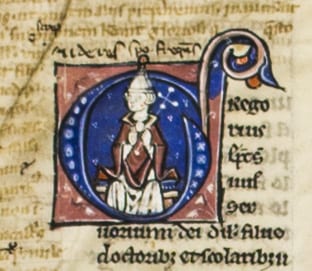 Gratian’s Decretum was a founding text for medieval canon law study in the same way that the Digest, Code, and Institutes were fundamental to the civil law revival. Yet there was a crucial difference between the two sciences: the source of civil law, Justinian’s compilation of Roman law, was fixed and unchanging, yet Church law continued to be made. Several other compilations of papal decretals, most notably five known as Quinque compilationes antiquœ, were generated in the decades after the Decretum appeared, until finally in 1234, Pope Gregory IX charged the Dominican friar Raymond of Peñafort to produce a new, definitive compilation of papal decretals. Raymond was a Catalan scholar renowned for his expertise in both civil and canon law; he studied and then taught at Bologna, serving as the chair of canon law there for a few years. The work he produced, known as the Decretales Gregorii IX or Liber extra (because it contained the decretals “extra” to Gratian’s Decretum) was meant to replace all former decretal collections, and Gregory IX issued a papal bull to the canon law faculties at Bologna and Paris declaring as much. Raymond’s work comprised five books whose contents students remembered by the verse “judex, judicium, clerus, connubia, crimen” (judges, judgments/proceedings, clergy, marriages, crime). The thirteenth-century manuscript edition displayed here was copied within just a few decades of the Liber extra’s creation. It contains many small illuminations throughout, most of them depicting Gregory IX.
Gratian’s Decretum was a founding text for medieval canon law study in the same way that the Digest, Code, and Institutes were fundamental to the civil law revival. Yet there was a crucial difference between the two sciences: the source of civil law, Justinian’s compilation of Roman law, was fixed and unchanging, yet Church law continued to be made. Several other compilations of papal decretals, most notably five known as Quinque compilationes antiquœ, were generated in the decades after the Decretum appeared, until finally in 1234, Pope Gregory IX charged the Dominican friar Raymond of Peñafort to produce a new, definitive compilation of papal decretals. Raymond was a Catalan scholar renowned for his expertise in both civil and canon law; he studied and then taught at Bologna, serving as the chair of canon law there for a few years. The work he produced, known as the Decretales Gregorii IX or Liber extra (because it contained the decretals “extra” to Gratian’s Decretum) was meant to replace all former decretal collections, and Gregory IX issued a papal bull to the canon law faculties at Bologna and Paris declaring as much. Raymond’s work comprised five books whose contents students remembered by the verse “judex, judicium, clerus, connubia, crimen” (judges, judgments/proceedings, clergy, marriages, crime). The thirteenth-century manuscript edition displayed here was copied within just a few decades of the Liber extra’s creation. It contains many small illuminations throughout, most of them depicting Gregory IX.
Elisei, Bonaccorso degli, De citationibus; Statuta Universitatis Bononiensis
(Southern France (?), between 1275 and 1325)
The manuscript folio reproduced below is the first page of the original statutes of the University of Bologna, the only existing copy of which is held by the Robbins Collection. Bologna was known as a center of learning for the liberal arts as early as 1000 A.D., but it truly flourished as the center for development of jurisprudence as a science, both through revival of Roman law and the civil law tradition by early masters such as Irnerius, Bulgarus, Azo and Accursius, and it symbolized the turning point in canon law study marked by Gratian and his Decretum.
The reputation of these Bologna-based scholars as teachers of law—but especially as glossators and commentators on the law—spread far and wide, drawing students to that city from all over Italy and north of the Alps, and sending Bologna-trained scholars back to found great centers of legal learning in other medieval universities such as Oxford and Paris (both founded in the twelfth century), Montpellier, Orleans, and Salamanca (thirteenth century), to name but a few of the earliest.
Teachers and students of law in Bologna gained a further degree of security and prestige when, in 1155, the Holy Roman Emperor Frederick Barbarossa published Authentica Habita, a decree that placed them under imperial protection. The teaching of law at Bologna was originally a private enterprise with teachers collecting fees directly from students. There was no campus, public subsidy or institutional framework. Students, who flocked to Bologna in order to be educated for careers in the service of powerful rulers of both state and church, first gathered in a society of scholars known as studium, or universitas studiorum. They eventually coalesced into guilds, or “nations,” which they formed to protect themselves against local authorities and to give them leverage with landlords and booksellers to keep the costs of goods and services in check. The first two student guilds divided the students into two groups: the universitas citramontanorum, the students from “this side of the mountains,” meaning Italy, and the universitas ultramontanorum, students from anywhere north of Italy and the Alps. Eventually the students from the north of the Alps split into more specific nations reflecting their territories of origin: French, Spanish, Provençal, Norman, Hungarian, Polish, etc.

Justinian I, Digestum vetus cum Glossa ordinaria Accursii
(Robbins MS 36: Bologna (?), betweem 1290 and 1330)
The manuscript edition of the Digest with Accursian gloss pictured below is notable for its great quantity of marginal notes, annotations and doodles, all of which attest to its heavy use by a succession of students over the centuries. Produced in Italy, probably Bologna, around the turn of the fourteenth century, the manuscript also vividly illustrates the diffusion of civil law from Bologna to other medieval universities: an inscription on the end leaf notes the book’s ownership by an Oxford law student who was forced to pawn the volume. To assist impoverished students in covering their expenses, private benefactors to Oxford and Cambridge often gave the universities money to establish “loan chests.” The loan chests operated like an academic pawn shop: students could leave collateral — usually books — in the chest in exchange for cash and then redeem their items once they repaid the loan. The Countess of Warwick established a loan chest at Oxford in the late thirteenth century, and an inscription at the back of Robbins MS 36 shows that an Oxford student, Thomas Bykken, deposited the manuscript in the Warwick Chest on the Vigil of Easter, 1347, to secure a loan of one mark. The image detail here at the foot of the manuscript shows the inscription, which reads, “Cautio apud Thoman … Bykken … in cista Warwycki in vigilia Paschae anno domini millesimo trecentesimo quadragesimo septimo … pro una marce.”
Henricus de Segusio, Commentarium libri Decretalium
(Robbins Collection MS 8: Bologna(?), between 1320 and 1340
Said by his contemporary Guillame Durand to be one of the greatest canonists of the thirteenth century, Henricus de Segusio (known as Hostiensis from his tenure as Cardinal Bishop of Ostia), taught canon law at the University of Paris and also spent some years in England, serving at one time as an emissary of King Henry III to Pope Innocent IV. Italian-born and Bologna-trained, Hostiensis and his career again demonstrate the influence of Bologna on other legal centers throughout Europe, and his work is exemplary of the utriusque iuris tradition of scholarly accomplishment in both the canon and civil law traditions. His 1253 Summa on the Gregorian Decretals, later named the Summa Aurea, was renowned as a masterful synthesis of Roman and canon law that addressed current practice as well as theory. His later Lectura, or Commentarium libri Decretalium, was his most important work, providing a full exegesis of each of the Gregorian decretals. The Lectura edition displayed below is a beautifully copied and illuminated manuscript from the fourteenth century; the small figure depicted here in the illuminated initial is Pope Gregory IX.
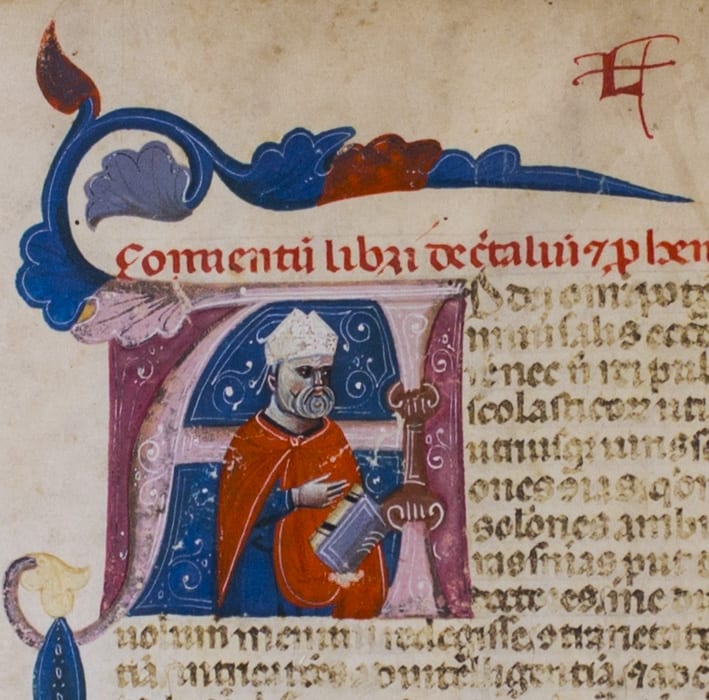
Clement V, Constitutiones
(Mainz, 1471)
The beautifully illuminated folio edition (below) of the Constitutiones Clementinae is an incunable (early printed book) edition from 1471. The Constitutiones Clementinae were, as the name suggests, a collection of decisions compiled under Clement V, following in kind the Liber extra of Gregory IX and the Liber sextus of Boniface VIII— in fact, the work is sometimes called the Liber septimus for this reason. While produced during Clement’s papacy, the work was published after his death by his successor, Pope John XXII, who had studied law in Paris. The Constitutiones Clementinae were the last official papal compilation of decretals in the Corpus iuris canonici, with the last two works in that collection, the Extravagantes communes and Extravagantes Joannis (both presenting several other decisions not previously included) having been privately produced.
Justinian I, Institutes
(Venice, 1478)
Originally designed as a textbook for law students, the Institutes has remained a resource for legal scholars over the centuries by presenting a more accessible, rationally ordered, and concise summary of the main concepts of Roman Law than the much larger and more comprehensive Digest. Modern students of American property law will recall the famous use of the Institutes in Pierson v. Post (1805), a hunting dispute on public land in which the defendant killed and carried off, in sight of the plaintiff, a fox that the latter had been actively “hunting, chasing, and pursuing” with his dogs. Deciding for the defendant, the New York Supreme Court cited Book II, Title 1, Section 12, of the Institutes as precedent for its finding that “[p]ursuit alone gives no right of property in animals ferae naturae, which can be acquired only by possession.” The original citation may be found in this 1478 edition near the end of the left page’s center text block, its beginning marked at the right by the manicula (pointing hand): “Ferae igitur bestiae, et volucrers, et pisces, et omnia animalia, quae mari, coelo, et terra nascuntur, simul atque ab aliquo capta fuerint, jure gentium statim illius esse incipiunt: quod enim ante nullius est id naturali ratione occupanti conceditur: nec interest feras bestias et volucres utrum in suo fundo quis capiat, an in alieno.” It is interesting to note that the faint ink doodle just to the left of the passage is a human figure with what appears to be a falcon, a wild bird of prey, overhead. The adjacent detail is from the first page of this edition, and highlights the beginning lines of the Institutes: “Imperial majesty should not only be embellished with arms but also fortified by laws so that the times of both war and peace can be rightly regulated.”
Gratian, Decretum
(Venice, 1480)
Gratian is widely regarded as the father of the science of canon law. His landmark work, known as the Decretum, formally titled Concordia discordantium canonum (Concord of Discordant Canons) was introduced in Bologna around 1140. More than a compilation, the Decretum was a groundbreaking, ambitious work in which Gratian not only synthesized existing compilations of canon law drawn from disparate sources (such as papal decisions, called “decretals,” and the writings of Church fathers) but also presented extensive analysis and commentary to reconcile, as the title suggests, contradictory canons. The impact of Gratian’s work was such that within two decades of its completion, canon law, formerly the province only of Church scholars and not professional jurists, was recognized at Bologna and beyond as a legal system and scholarly discipline separate from but equal in importance to the civil law system. Although the two systems were separate, they were dominated by many of the same fundamental problems and questions (marriage and succession, for example) and in many respects Roman law was as important a source for the canon law scholars as ecclesiastical authorities such as Ivo of Chartres.
Justinian I, Digest
(Nuremberg, 1482)
The great compilation of law ordered by Byzantine emperor Justinian between 529 and 534 CE was destined to become the foundational source for Roman law in the Western tradition. All later systems of law in the West borrowed from it, including the civil law systems of Europe, Latin America, and parts of Africa, and to a lesser but still notable extent the English common law system. The three-part compilation drew on all existing imperial pronouncements having the force of law back to the time of Hadrian: the Digest (Digesta or Pandectae) collected and summarized all of the classical jurists’ writings on law and justice; the Code (Codex) outlined the actual laws of the empire, citing imperial constitutions, legislation and pronouncements; and the Institutes (Institutiones) was a smaller summary of the Digest for students of law. The Western Empire had fallen by 480 CE, and Justinian’s military recovery of Italy and North African territories around the time of the compilation lasted a little more than twenty years. Most of the compilation was lost to western scholars within decades of its creation; while the Institutes remained known in certain form, it was not until the discovery of a manuscript copy of the Digest in eleventh-century Italy that the full compilation became known to scholars once again. These ancient texts sparked a revival of Roman law and the founding of a medieval civil law tradition that began in Bologna and spread throughout Europe. In the sixteenth century, these texts were given the name Corpus iuris civilis (Body of Civil Law).
Editions such as this one from in the earliest years of printing (before 1501) are called incunables. The page displayed demonstrates how incunables retained many of the formatting conventions that had evolved over time in manuscripts, such as the central text surrounded by the supporting gloss, the incipit and explicit lines (often, as here, in red print) that marked the beginning and end, respectively, of a book and its major sections, the illuminated initials and the gothic typeface. Spaces such as the one above the red incipit and central text were left by the printers for illuminations and initials to be added by hand.
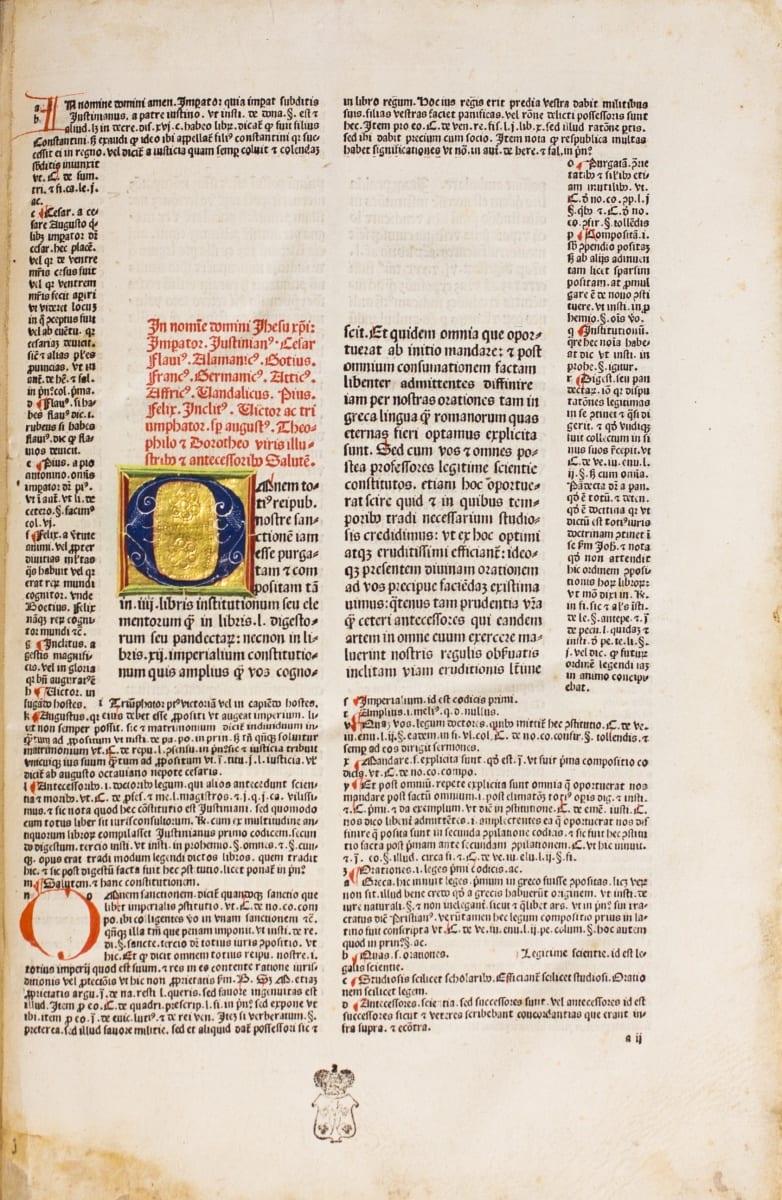
Ivo of Chartres, Liber decretorum siue Panormia Iuonis accurato labore summoque studio in vnum redacta continens
(Basel, 1499)
Ivo, a French bishop and scholar whose expertise in canon law gave him a role in the great Investiture Controversy, produced three of the eleventh century’s most important canonical compilations, Collectio tripartita, Decretum, and Panormia. Ivo’s work had immediate and far-reaching impact, its use extending to Eastern Europe and even Scandinavia by the end of the century—the first such dissemination of a set of canonical texts throughout the continent. Contemporaneous with the revival of Roman law studies in Bologna, Ivo’s canon law work is seminal to the development and diffusion of medieval legal tradition. Of the three compilations, Decretum was the most extensive, comprising seventeen volumes, but the usefulness of the concise handbook Panormia made it the most widely used, and along with the Collectio Tripartita, it would later serve as an important source for Gratian in his own monumental compilation some forty years later.
Boniface VIII, Liber sextus Decretalium
(Lyon, 1511)
The Decretum and Gregorian Decretals together were considered to represent the law of the Church and established a structure for the presentation of canon law—they were the first two works of what would become the Corpus iuris canonici. The next work destined for the Corpus was the compilation of decretals that Boniface VIII promulgated in 1298 with the same intent as Gregory IX and Raymond of Peñafort, to create a new authoritative compilation. Called the Liber sextus decretalium, because it came after the five books of the Gregorian Liber extra, Boniface’s work did not add any new subjects, but expanded the contents of the Decretum and Liber extra in its addition of Church Council and papal decisions that had been issued since the papacy of Gregory IX. This edition of the Liber sextus is bound with the Constitutiones Clementinae, Extravagantes communes, and Extravagantes Joannis, three additional compilations of papal decretals that would round out the Corpus iuris canonici, and includes the glosses of renowned canoinsts Johannes Andreae and Johannes Monachus.
Because the concept of marriage had such great importance in canon law (just as it did in civil law), central to questions of family law, succession and inheritance, it was a frequent and extensive subject of scholarship in all the works of the Corpus iuris canonici, as well as many of the treatises of the great canonists. Many legal issues depended upon the degrees of family relationship by blood or marriage. It was thus very common for legal commentaries to include reference tool known as trees of consanguinity and trees of affinity, detailed and often beautifully illustrated charts that graphically demonstrated the various generations and degrees of familial relations. Trees of consanguinity reflected relationships by blood, while trees of affinity showed relationships by marriage. The image below is a tree of consanguinity from the 1511 Liber sextus.
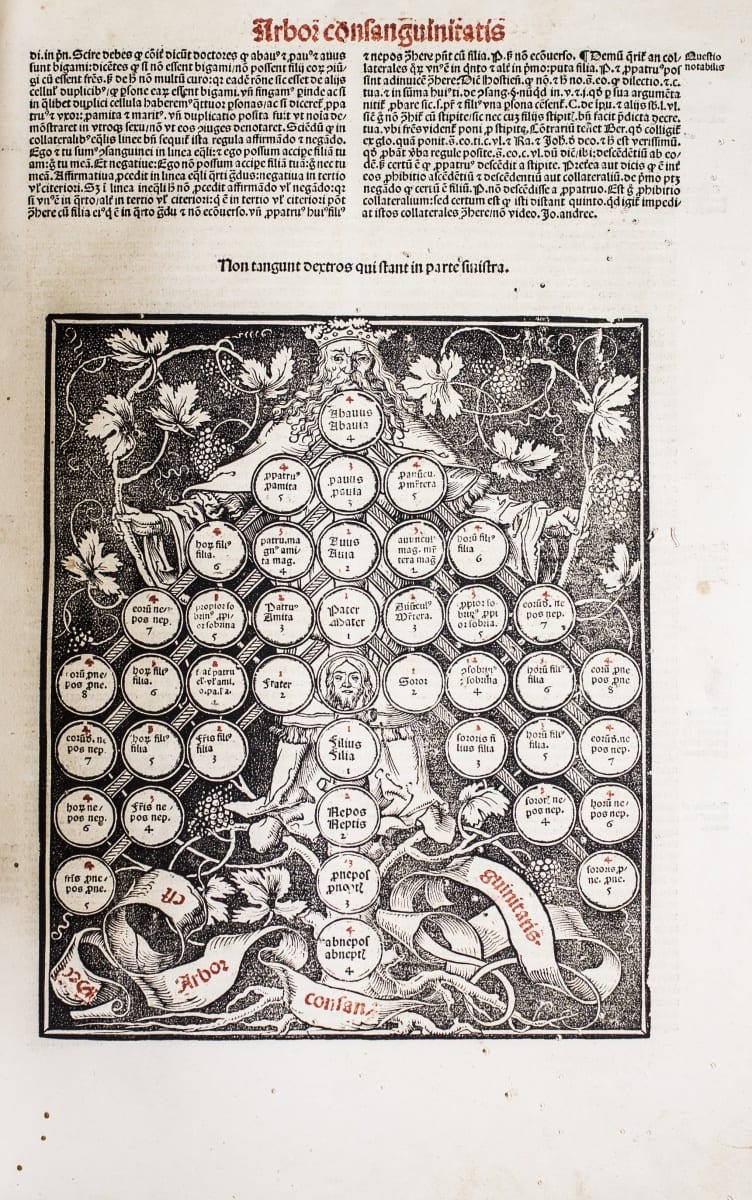
Azo, Portuis, Summa Azonis
(Lyon, 1514)
Upon rediscovery of the Digest in the late eleventh century, Bologna scholars set themselves to the task of interpreting the language and substance of Justinian’s extensive and often confusingly-organized texts. Accepting Justinian’s assertion that the compilation was comprehensive and without contradictions, holding within it the answer to any legal question, the earliest generations of civil law masters at Bologna produced a great quantity of analytical writing and commentary on the sixth-century compilation. These comments or “glosses,” as they were called, were first written in between the lines and then around the margins of the original works, establishing the manuscript format of a central block of original text and surrounding gloss that would continue into centuries of print and is easily recognizable in the works throughout this exhibit.
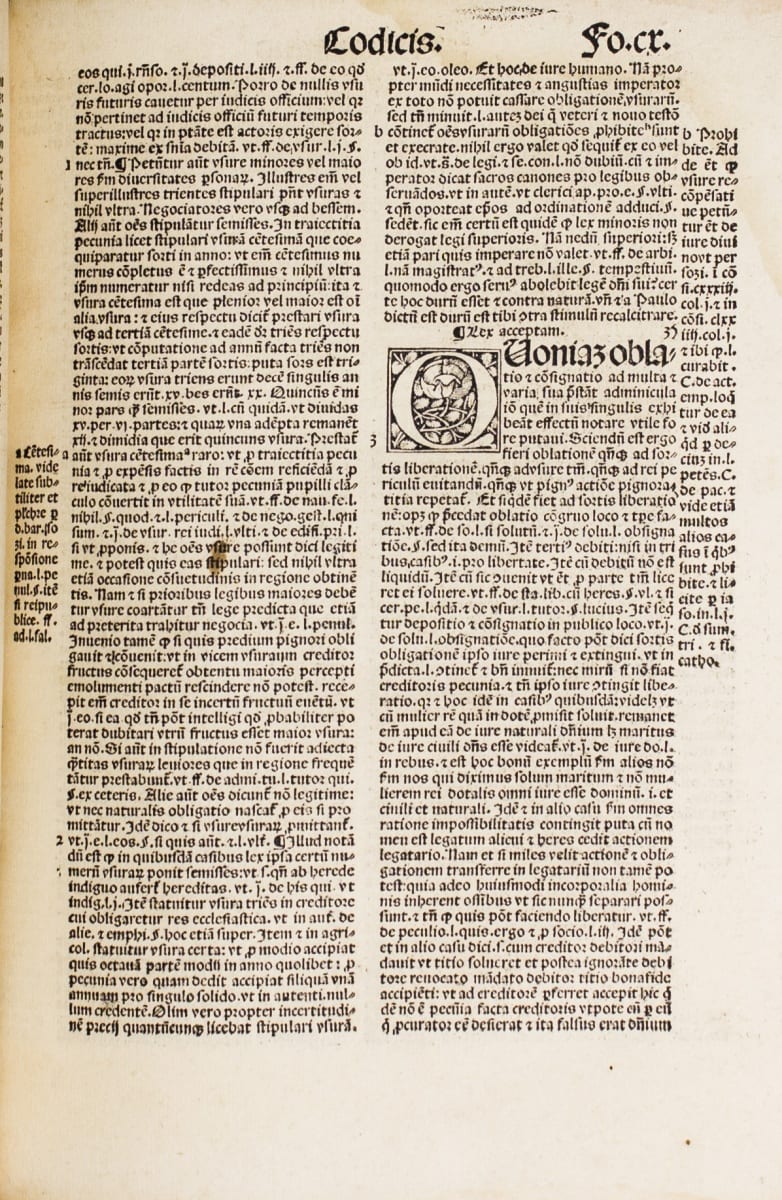
Ubaldi, Baldo delgi, Baldus super feudis: opus aurem vtriusq[ue] iuris luminis domini Baldi de Perusia super feudis…
(Lyon, 1522)
Bartolus’s most distinguished follower was Baldus de Ubaldis, who studies under him and later taught alongside him at Perugia. Like many great medieval legal scholars, Baldus was a Doctor utriusque iuris, trained in both laws. Beginning in mid-twelfth century, the term utrumque ius, “the one and the other law,” described the combined study of Roman civil and canon law. This tradition of dual study reflects the close relationship between two fields, and in particular the debt that canon law owed to civil law as a formal discipline, in its analytical and procedural foundation and its terminology. Baldus was a prolific teacher—in addition to his thirty-three-year tenure at Perguia, he also taught at Bologna, Pisa, Florence, Padua, and Pavia. He wrote civil law commentaries on the Digest and Code and canon law commentaries on the Liber extra and Liber sextus, as well as approximately 3,000 consilia (legal opinions), a number unmatched by any medieval contemporary. Not limiting himself to the “two laws,” Baldus also took up the study of feudal law toward the end of his career. His commentary on the Libri feudorum, displayed below, was the most important medieval treatise on feudal law. Although the Libri feudorum came to be included in the Corpus Iuris civilis, feudal law did not occupy a great place in early civil and canon law cirriculums. But feudal relationships, and the rights and obligations that went with them, were a political and economic reality of the time, and medieval jurists increasingly turned their attention, both as scholars and practitioners, to feudal disputes and the legal solutions they required.
Durand, Guillaume, Speculum judiciale
(Lyon, 1543)
Completed in 1271 by Guillaume Durand, a canon lawyer from Languedoc who trained in Bologna, Speculum judiciale (Mirror of Justice) was a masterfully organized encyclopedia of legal procedure, synthesizing Roman and canon law work. Since the early years of the legal revival at Bologna, civil and canon law scholars alike had worked to extract procedural elements from the Roman sources, and these efforts reached their pinnacle in Durand’s work, which covered civil, criminal, and canonical procedure in four books that examined the parties involved in legal action, civil and criminal procedure, and pleas. The intelligence and clarity of the Speculum judiciale made it an indispensable reference for many generations of both scholars and practitioners and earned Durand the nickname The Speculator.
Bartolus of Sassoferrato, Dn. Bartoli de Saxoferrato iurisconsulti clarissimi super Institutionibus iuris ciulis commentaria…
(Lyon, 1559)
Bologna continued to be a preemient center for legal and training for many centuries. Bartolus, who trained at Bologna and went on to teach at Perugia, was one of the most prominent continental jurists of the Middle Ages. He wrote exhaustive commentaries on all parts of the Corpus Iuris Civilis, such as this work on the Institutes, with an eminently practical approach, seeking not simply to understand the texts as they had been handed down, but to draw from them rules which would be applicable to the legal problems of the day. By drawing out a coherent rationale from the terse and often conflicting rulings of the Roman texts, Bartolus was able to establish rules that themselves had the force of law. His methods were followed by the later generations of Commentators, scholars whose work came to dominate the study of civil law during the fourteenth and fifteenth centuries.
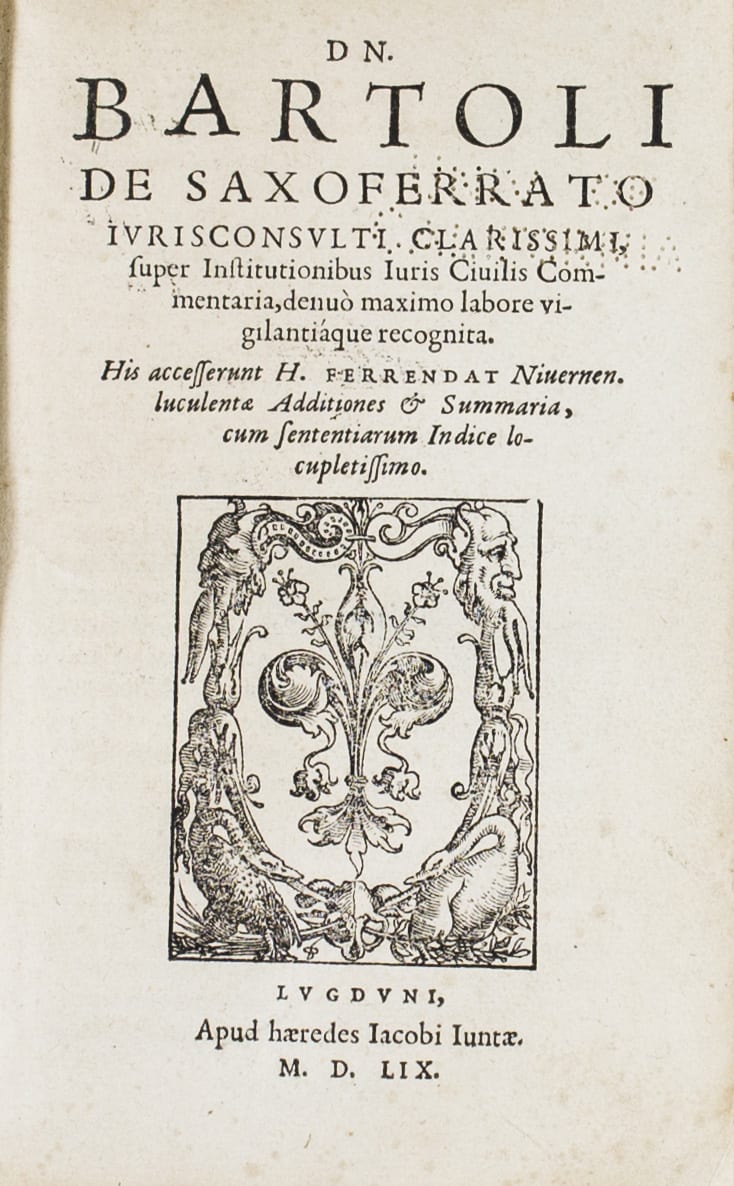
Modus legendi abbreviaturas passim in iure tam ciuli quam pontificio occurrentes…
(Lyon, 1564)
Modus legendi abbreviaturas is a handbook for reading abbreviations found in texts of Roman civil law and canon law (in utroque iure). The introduction and success of such practical handbooks reflects the growing professionalization of the role of the canon lawyer, as well as the need for that lawyer to be knowledgeable in both fields of law. This reference tool was first produced in 1475, and was in such demand that twenty different editions were printed before the end of the century, with around twenty more editions appearing after 1500. The need to be able to read abbreviations in itself demonstrated the continuing importance of the manuscript tradition, which for both economic and practical reasons, had over the centuries developed elaborate systems of abbreviation. These medieval abbreviations were so prevalent in the medieval sources that they were long carried over into printed books, particularly in the fifteenth and sixteenth centuries.
Bulgarus, and Placentinus, Petrus, Bulgari et Placentini, veterum iurisonsultorum ad titulum Pandectarum De diuersis regulis iuris antiqui, breues duo et elegantes commentarij…
(Cologne,1587)
These comments on the final title of the last book of the Digest were long attributed solely to the early Bologna glossator Placentinus, until the great sixteenth-century French legal humanist Jacques Cujas discovered that in fact part of the work was actually that of the earlier Bologna master Bulgarus. Placentinus was part of the very early diffusion of civil law teaching from Bologna to other parts of Europe, migrating to Montpellier in southern France and teaching law there in the late twelfth century.
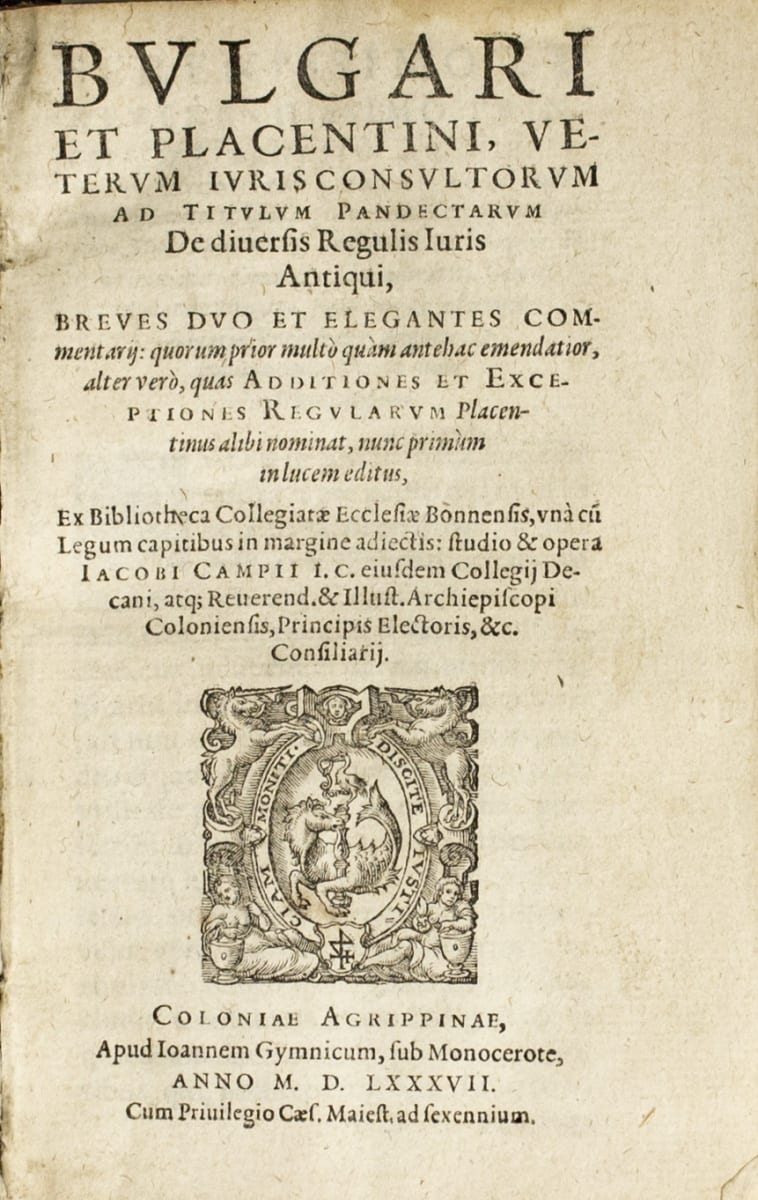
The Institutes of Justinian. With notes by Thomas Cooper
(Philadelphia, 1812)
This is the first American edition of the Institutes. Translator and editor Thomas Cooper, a professor of natural philosophy and chemistry as well as a scholar of law, also wrote the first treatise on American bankruptcy law. Cooper sent a copy of the newly published Institutes edition to his friend Thomas Jefferson, who replied, “I possessed Theopilus’, Vinnius’, and Harris’ editions, but read over our notes and the addenda et corrigenda, and especially the parallels with the English law, with great satisfaction and edification. Your edition will be very useful to our lawyers, some of whom will need the translation as well as the notes.” Indeed, the pages displayed here offer the translation of the passage cited in Pierson v. Post: “Wild beasts, birds, fish, and all animals bred either in the sea, the air, or upon the earth, so soon as they are taken, become by law of nations, the property of the captor: for natural reason gives to the first occupant, that which has no previous owner.”
[Manuscript detail] Justinian I, Digest
(Florence, facsimile edition of sixth-century Byzantine manuscript)
This folio detail is from a facsimile edition of the original sixth-century manuscript discovered in the eleventh century and currently held in the Laurentian Library in Florence—the only existing copy of this foundational work. It is written in both Latin and Greek, reflecting its origins in the Byzantine Empire, where Greek was the lingua franca. Both languages are visible on the page shown, switching from Latin to Greek in the bottom half of the left column, and switching back to Latin in the bottom half of the right column. The names of different jurists appear at the beginning of several of the paragraphs (Paulus, Ulpianus, Modestinus) and convey a sense of how the Digest was organized, with the commentaries of various jurists extracted and compiled into various sections, or “books,” according to subject.
Follow the link below to access a print-friendly PDF version of “The Medieval Law School” resource, complete with sources, glossary, photos, and bibliography.
We have made a video version of this exhibit available below.
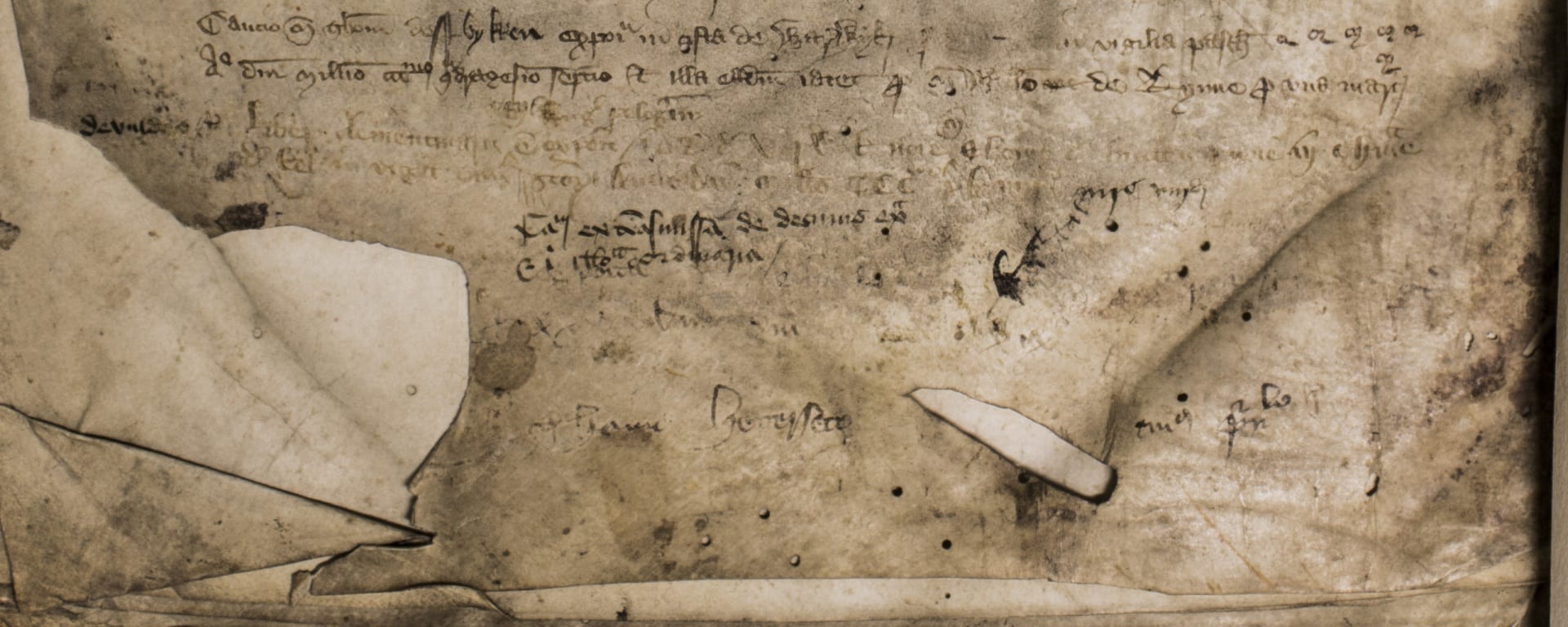
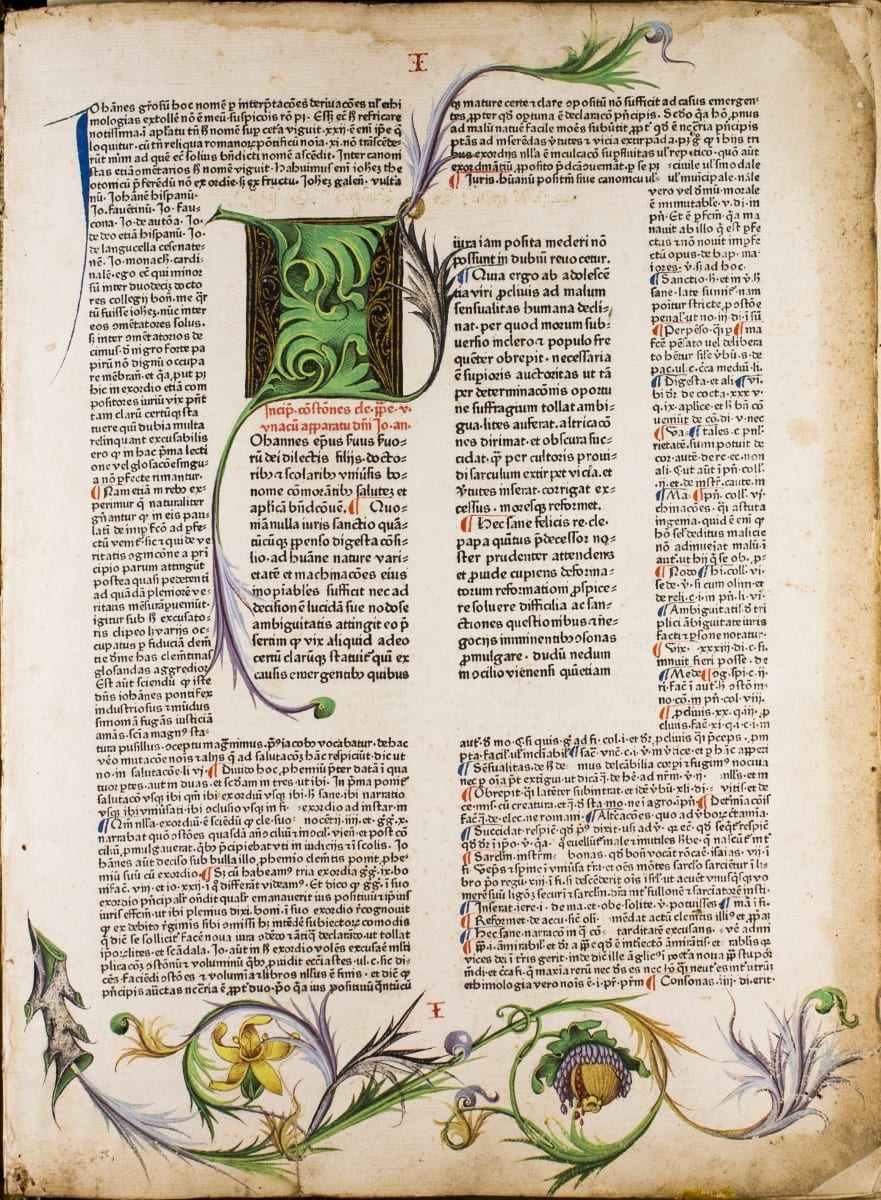
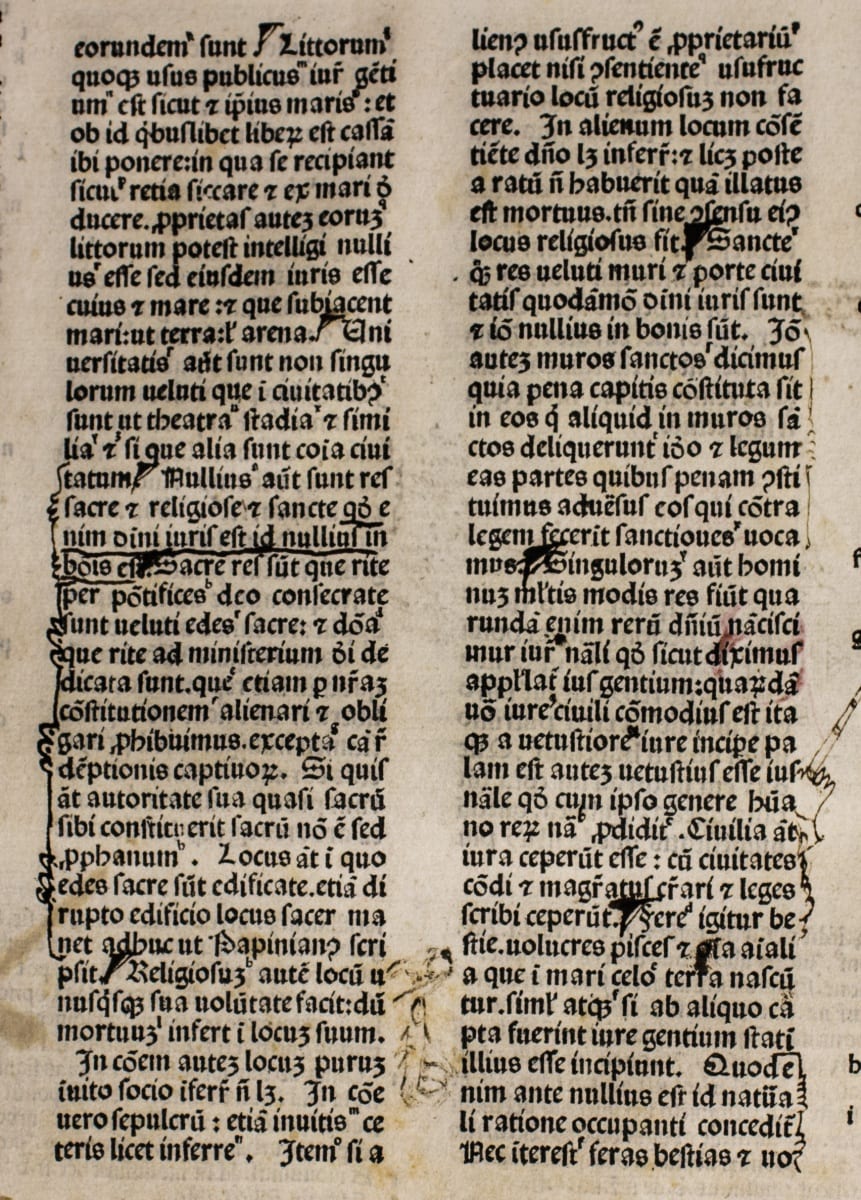
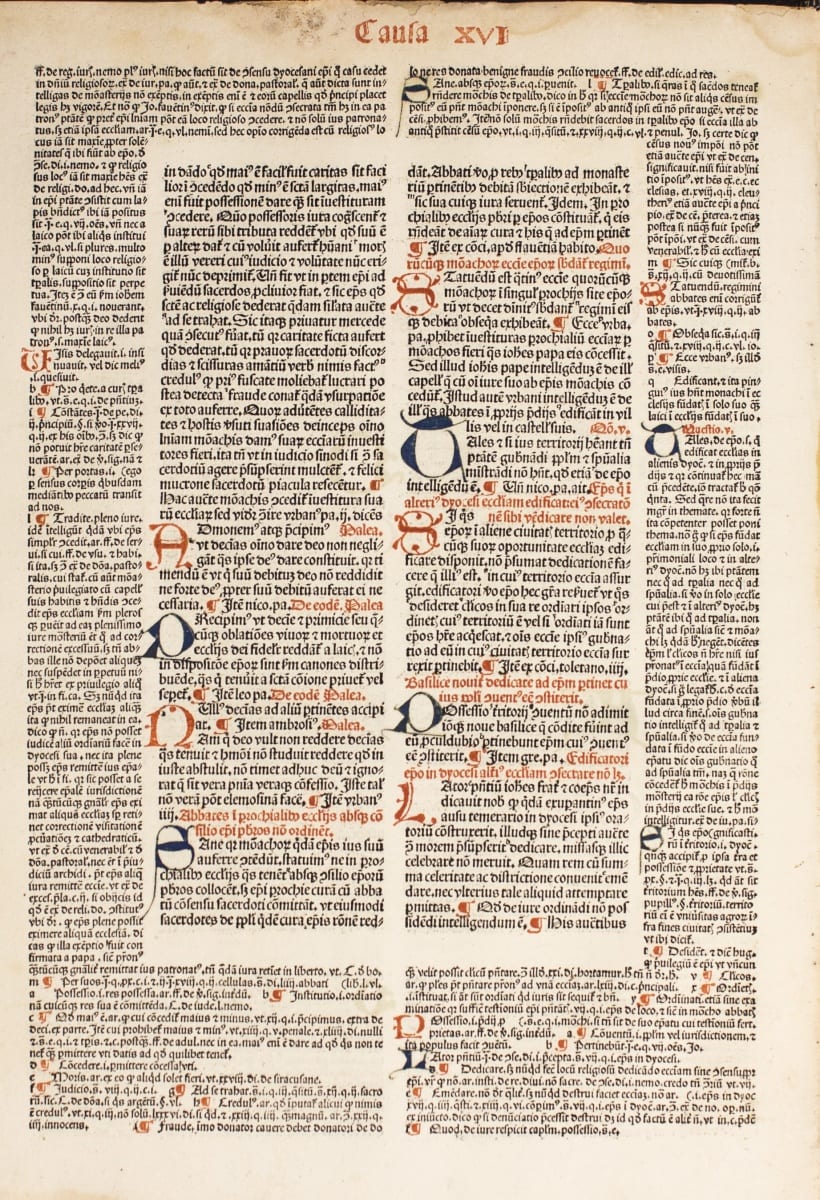
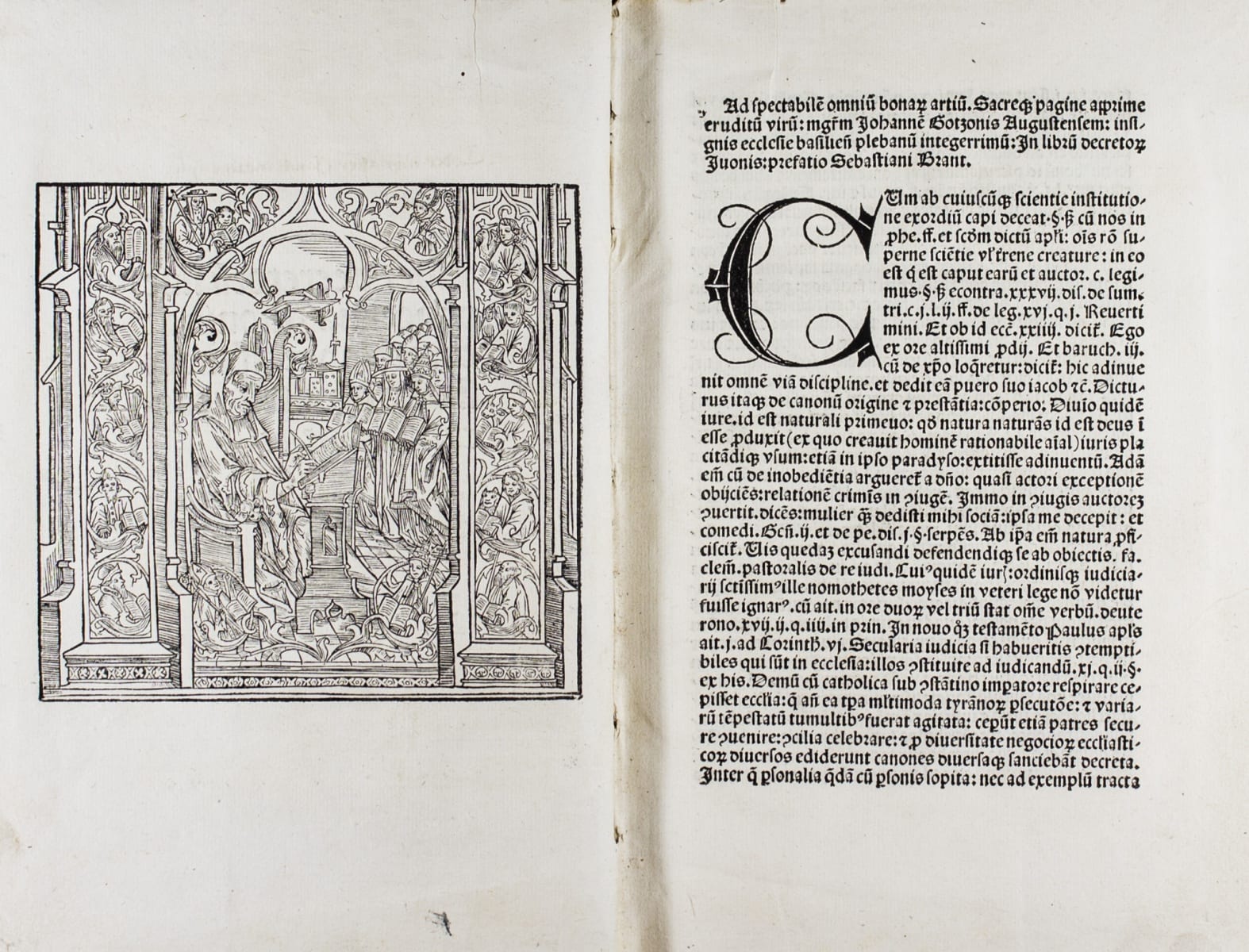
![Baldus super feudis: opus aurem vtriusq[ue] iuris luminis domini Baldi de Perusia super feudis](https://www.law.berkeley.edu/wp-content/uploads/2016/12/kjc4434.5v251522.jpg)
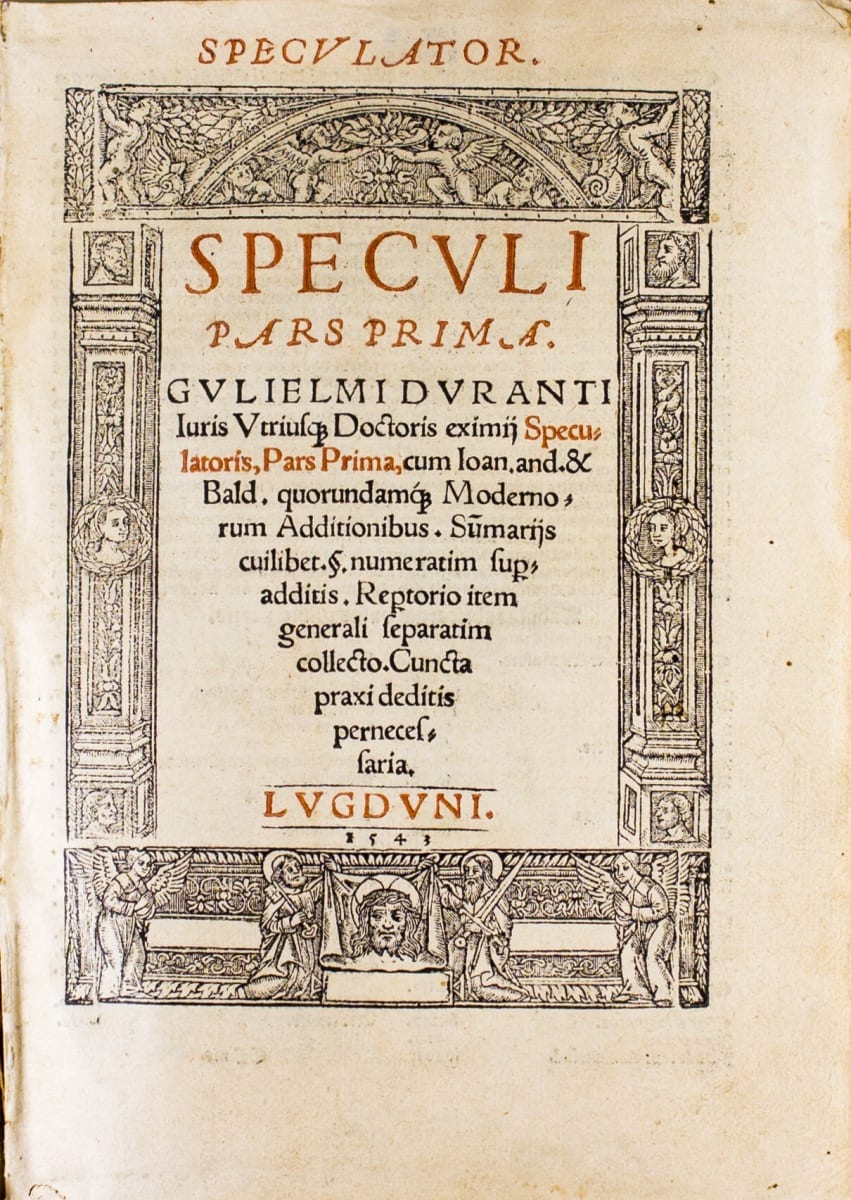
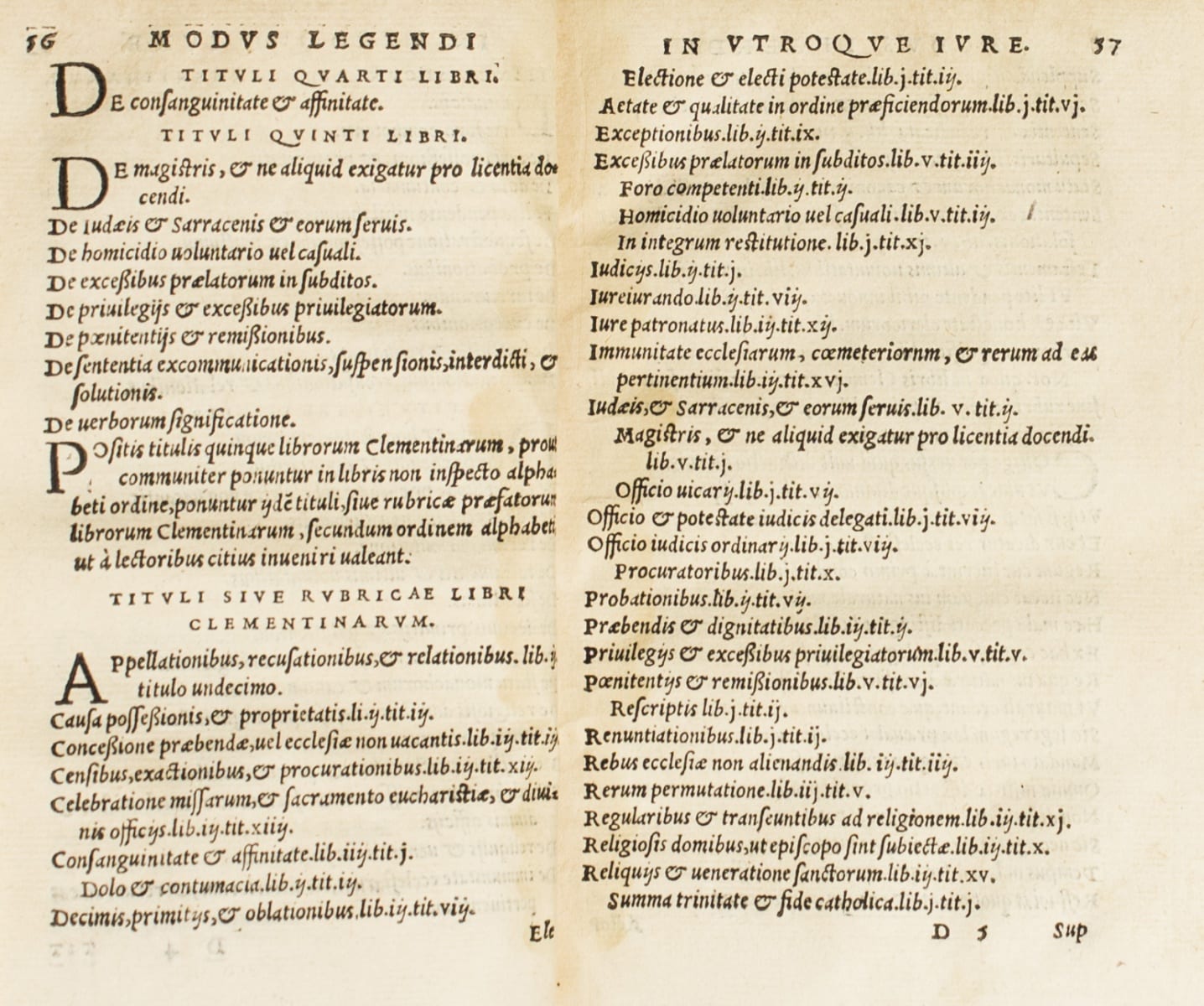
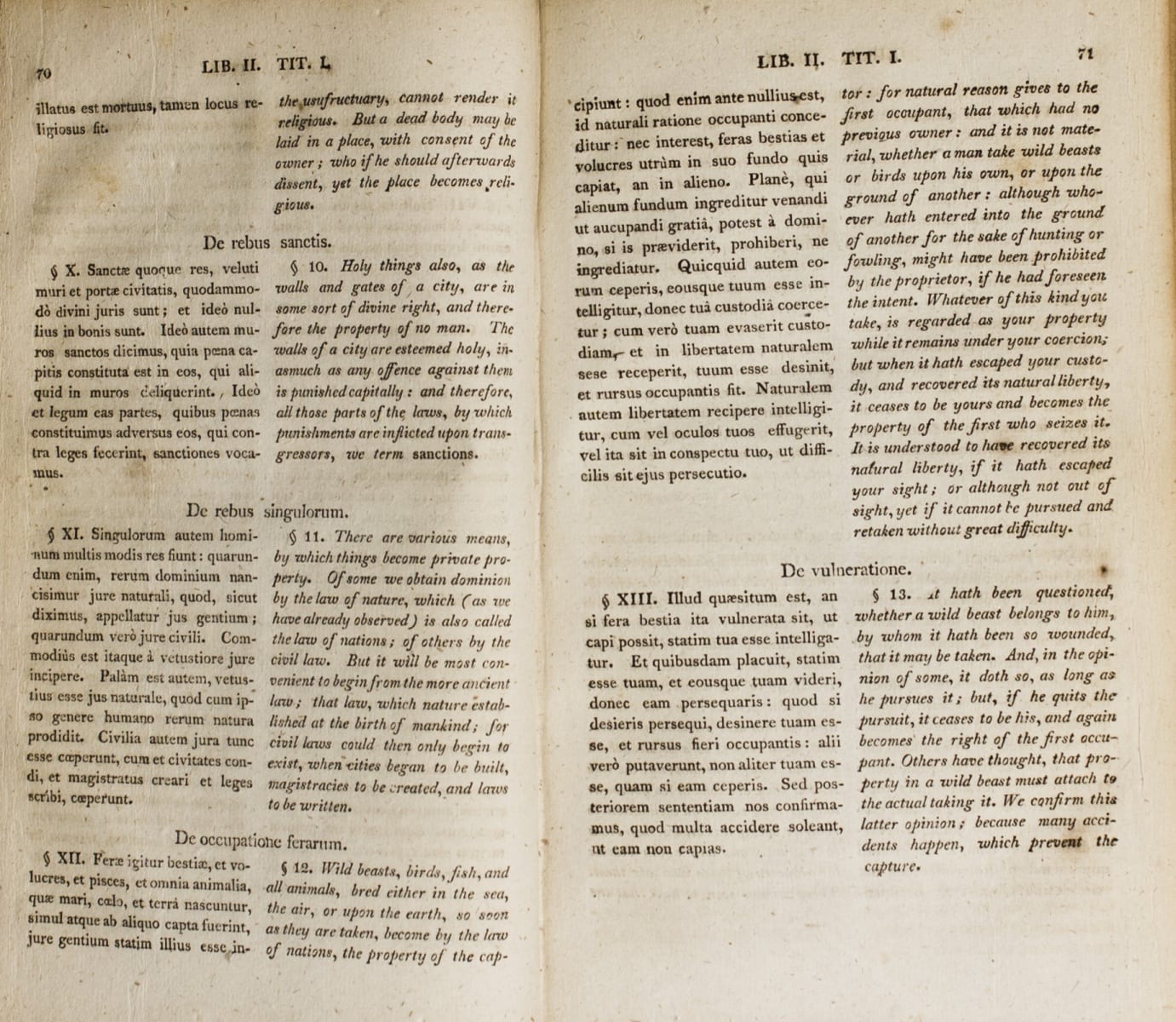
![[Manuscript detail] Justinian I, Digest](https://www.law.berkeley.edu/wp-content/uploads/2016/12/kbd42c65.jpg)